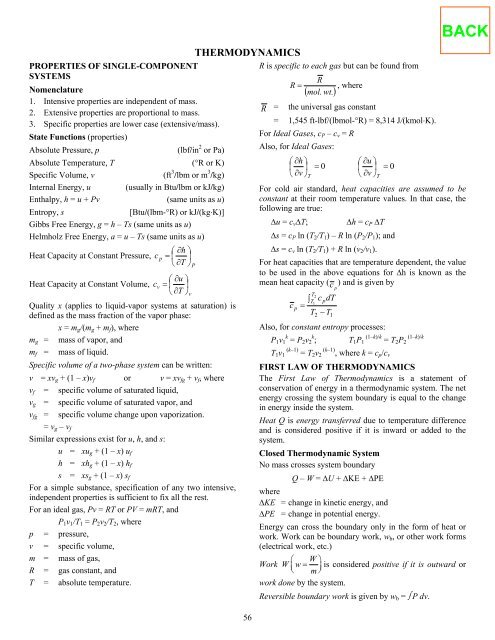fundamentals of engineering supplied-reference handbook - Ventech!
fundamentals of engineering supplied-reference handbook - Ventech!
fundamentals of engineering supplied-reference handbook - Ventech!
You also want an ePaper? Increase the reach of your titles
YUMPU automatically turns print PDFs into web optimized ePapers that Google loves.
PROPERTIES OF SINGLE-COMPONENT<br />
SYSTEMS<br />
Nomenclature<br />
1. Intensive properties are independent <strong>of</strong> mass.<br />
2. Extensive properties are proportional to mass.<br />
3. Specific properties are lower case (extensive/mass).<br />
State Functions (properties)<br />
Absolute Pressure, p (lbf/in 2 or Pa)<br />
Absolute Temperature, T (°R or K)<br />
Specific Volume, v (ft 3 /lbm or m 3 /kg)<br />
Internal Energy, u (usually in Btu/lbm or kJ/kg)<br />
Enthalpy, h = u + Pv (same units as u)<br />
Entropy, s [Btu/(lbm-°R) or kJ/(kg⋅K)]<br />
Gibbs Free Energy, g = h – Ts (same units as u)<br />
Helmholz Free Energy, a = u – Ts (same units as u)<br />
⎛ ∂h<br />
⎞<br />
Heat Capacity at Constant Pressure, c p = ⎜ ⎟<br />
⎝ ∂T<br />
⎠<br />
⎛ ∂u<br />
⎞<br />
Heat Capacity at Constant Volume, cv = ⎜ ⎟<br />
⎝ ∂T<br />
⎠<br />
Quality x (applies to liquid-vapor systems at saturation) is<br />
defined as the mass fraction <strong>of</strong> the vapor phase:<br />
x = mg/(mg + mf), where<br />
mg = mass <strong>of</strong> vapor, and<br />
mf = mass <strong>of</strong> liquid.<br />
Specific volume <strong>of</strong> a two-phase system can be written:<br />
v = xvg + (1 – x)vf or v = xvfg + vf, where<br />
vf = specific volume <strong>of</strong> saturated liquid,<br />
vg = specific volume <strong>of</strong> saturated vapor, and<br />
vfg = specific volume change upon vaporization.<br />
= vg – vf<br />
Similar expressions exist for u, h, and s:<br />
u = xug + (1 – x) uf<br />
h = xhg + (1 – x) hf<br />
s = xsg + (1 – x) sf<br />
For a simple substance, specification <strong>of</strong> any two intensive,<br />
independent properties is sufficient to fix all the rest.<br />
For an ideal gas, Pv = RT or PV = mRT, and<br />
P1v1/T1 = P2v2/T2, where<br />
p = pressure,<br />
v = specific volume,<br />
m = mass <strong>of</strong> gas,<br />
R = gas constant, and<br />
T = absolute temperature.<br />
v<br />
P<br />
THERMODYNAMICS<br />
56<br />
R is specific to each gas but can be found from<br />
R<br />
R = , where<br />
mol. wt.<br />
( )<br />
R = the universal gas constant<br />
= 1,545 ft-lbf/(lbmol-°R) = 8,314 J/(kmol⋅K).<br />
For Ideal Gases, cP – cv = R<br />
Also, for Ideal Gases:<br />
⎛ ∂h<br />
⎞<br />
⎜ ⎟<br />
⎝ ∂v<br />
⎠<br />
= 0<br />
⎛ ∂u<br />
⎞<br />
⎜ ⎟<br />
⎝ ∂ν<br />
⎠<br />
= 0<br />
T<br />
For cold air standard, heat capacities are assumed to be<br />
constant at their room temperature values. In that case, the<br />
following are true:<br />
∆u = cv∆T; ∆h = cP ∆T<br />
∆s = cP ln (T2/T1) – R ln (P2/P1); and<br />
∆s = cv ln (T2/T1) + R ln (v2/v1).<br />
For heat capacities that are temperature dependent, the value<br />
to be used in the above equations for ∆h is known as the<br />
mean heat capacity ( c<br />
) and is given by<br />
p<br />
T2<br />
∫T<br />
c dT<br />
1 p<br />
c p =<br />
T − T<br />
2<br />
Also, for constant entropy processes:<br />
1<br />
P1v1 k = P2v2 k ; T1P1 (1–k)/k = T2P2 (1–k)/k<br />
T1v1 (k–1) = T2v2 (k–1) , where k = cp/cv<br />
FIRST LAW OF THERMODYNAMICS<br />
The First Law <strong>of</strong> Thermodynamics is a statement <strong>of</strong><br />
conservation <strong>of</strong> energy in a thermodynamic system. The net<br />
energy crossing the system boundary is equal to the change<br />
in energy inside the system.<br />
Heat Q is energy transferred due to temperature difference<br />
and is considered positive if it is inward or added to the<br />
system.<br />
Closed Thermodynamic System<br />
No mass crosses system boundary<br />
Q – W = ∆U + ∆KE + ∆PE<br />
where<br />
∆KE = change in kinetic energy, and<br />
∆PE = change in potential energy.<br />
Energy can cross the boundary only in the form <strong>of</strong> heat or<br />
work. Work can be boundary work, wb, or other work forms<br />
(electrical work, etc.)<br />
⎛ W ⎞<br />
Work W⎜w= ⎟ is considered positive if it is outward or<br />
⎝ m ⎠<br />
work done by the system.<br />
Reversible boundary work is given by wb = ∫ P dv.<br />
T
















